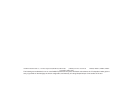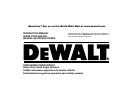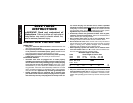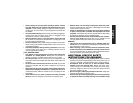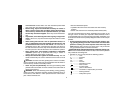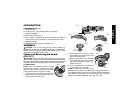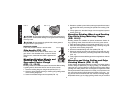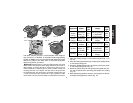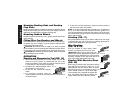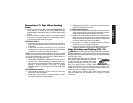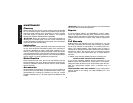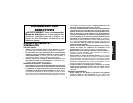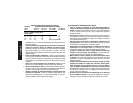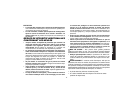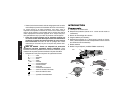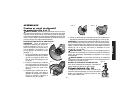
English
2
or its own cord. Contact with a “live” wire will make exposed metal
parts of the tool “live” and shock the operator.
• Before using, inspect recommended accessory for cracks or
flaws. If such a crack or flaw is evident, discard the accessory.
The accessory should also be inspected whenever you think
the tool may have been dropped. Flaws may cause wheel break-
age.
• In operation, avoid bouncing the wheel or giving it rough treat-
ment. If this occurs, stop the tool and inspect the wheel for cracks
or flaws.
• When starting the tool with a new or replacement wheel, or a
new or replacement wire brush installed, hold the tool in a well
protected area and let it run for one minute. If the wheel has an
undetected crack or flaw, it should burst in less than one minute. If
the wire brush has loose wires, they will be detected. Never start the
tool with a person in line with the wheel. This includes the operator.
• Direct sparks away from operator, bystanders or flammable
materials. Sparks may be produced while using a sander or
grinder. Sparks may cause burns or start fires.
• Always use side handle. Tighten the handle securely. The side
handle should always be used to maintain control of the tool at all
times.
CAUTION: Use extra care when grinding into a corner as a sudden,
sharp movement of the grinder may be experienced when the wheel or
other accessory contacts a secondary surface.
• Clean out your tool periodically. Dust and grit containing metal
particles often accumulate on interior surfaces and could create an
electric shock hazard.
WARNING: Some dust created by power sanding, sawing, grinding,
drilling, and other construction activities contains chemicals known to
cause cancer, birth defects or other reproductive harm. Some exam-
ples of these chemicals are:
• lead from lead-based paints.
• crystalline silica from bricks and cement and other masonry
products.
• arsenic and chromium from chemically-treated lumber(CCA).
Your risk from these exposures varies, depending on how often you do
this type of work. To reduce your exposure to these chemicals: work in
a well ventilated area, and work with approved safety equipment, such
as those dust masks that are specially designed to filter out microscopic
particles.
• Avoid prolonged contact with dust from power sanding, saw-
ing, grinding, drilling, and other construction activities. Wear
protective clothing and wash exposed areas with soap and
water. Allowing dust to get into your mouth, eyes, or lay on the skin
may promote absorption of harmful chemicals.
CAUTION: Wear appropriate hearing protection during use.
Under some conditions and duration of use, noise from this product
may contribute to hearing loss.
• The label on your tool may include the following symbols.
V ....................volts
A ....................amperes
Hz ..................hertz
W ....................watts
min..................minutes
..................alternating current
..............direct current
n
o....................no load speed
....................
Class II Construction
…/min..............revolutions or reciprocation per minute
..................earthing terminal
..................safety alert symbol



